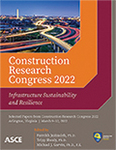Analyzing the Resilience of Construction Firms through Resilience Indicators
Publication: Construction Research Congress 2022
ABSTRACT
Preparing construction firms for an upcoming disaster is as important as community planning. While the latter has so much study and research go into it, the former is not given much importance as shown in the literature review. Resilience frameworks are designed to measure resilience of a community, a city, or state quantitatively or qualitatively. There are numerous frameworks based on state, disaster type input variables, and outcome from a framework. Indicators play a key role in any of the above-mentioned resilience frameworks. For each resilience framework designed in the past, there are several indicators that vary based on the type of disaster. The indicators also depend on whether the framework is designed for pre-disaster preparedness or post-disaster recovery. In this study, the resilience indicators used in the frameworks previously are identified and listed that could be used for a construction resilience framework. The authors of this study will address construction firms as one of the important firms to respond in case of a disaster occurrence. The objective is to identify indicators from the literature that are related to the construction industry. The methodology of this paper utilizes an existing tool that is used to develop resilience indicators. Conclusions include the identified resilience indicators and also discusses the scope of research that is currently being done by the authors.
Get full access to this article
View all available purchase options and get full access to this chapter.
REFERENCES
Barbosa, A. R., Fahnestock, L. A., Fick, D. R., Gautam, D., Soti, R., Wood, R., Moaveni, B., Stavridis, A., Olsen, M. J., and Rodrigues, H. (2017). “Performance of Medium-to-High Rise Reinforced Concrete Frame Buildings with Masonry Infill in the 2015 Gorkha Nepal Earthquake.” Earthquake Spectra. Earthquake Spectra: December 2017, Vol. 33, No. S1, pp. S197–S218.
Berkes, F., and Ross, H. (2012). “Community Resilience: Toward and Integrated Approach,” An International Journal of Society and Natural Resources, Taylor & Francis Online, Volume 26, Issue 1.
Brando, G., Rapone, D., Spacone, E., O'Banion, M. S., Olsen, M. J., Barbosa, A. R., Faggella, M., Gigliotti, R., Liberatore, D., Russo, S., and Sorrentino, L. (2017). “Damage Reconnaissance of Unreinforced Masonry BearingWall Buildings after the 2015Gorkha, Nepal, Earthquake. “Earthquake Spectra. Vol. 33, No. S1, pp. S243–S273.
(NAS 2015). Resilient America Roundtable; Policy and Global Affairs; National Research Council. Washington (DC): National Academies Press (US).
Cutter, S. L., Burton, C. G., and Emrich, C. (2010). “Disaster Resilience Indicators for Benchmarking Baseline Conditions,” Journal of Homeland Security and Emergency Management, Volume 7, Issue 1.
Djalante, R., and Thomalla, F. (2010). “Community Resilience to Natural Hazards and Climate Change Impacts: A Review of Definitions and Operational Frameworks,” 5th Annual International Workshop & Expo on Sumatra Tsunami Disaster & Recovery.
Figueiredo, L., Honiden, T., and Schumann, A. (2018). “Indicators for Resilient Cities”, OECD Regional Development Working Papers, No. 2018/02, OECD Publishing, Paris, https://doi.org/10.1787/6f1f6065-en.
Huber, G. J., Gomes, J. O., and Carvalho, P. V. R. (2012). “A Program to Support the Construction and Evaluation of Resilience Indicators,” DOI: https://doi.org/10.3233/WOR-2012-0528-2810, Pages 2810–2816.
Jovanovic, A. S., Klimek, P., and Choudhary, A. (2016). “Analysis of existing assessment resilience approaches, indicators and data sources: Usability and limitations of existing indicators for assessing, predicting and monitoring critic,” DOI: https://doi.org/10.13140/RG.2.2.32597.93927, Technical Report.
Khalil, S., Harre, M., and Morley, P. (2015). “A temporal framework of social resilience indicators of communities to flood, case studies: Wagga wagga and Kempsey, NSW, Australia,” International Journal of Disaster Risk Reduction, Volume 13, Pages 248–254.
Khanal, R. C. (2018). “Integrating Resilience Concept in the Face of Changing Climate: Learning from some NRM Projects in Nepal,” Irrigation in Local Adaptation and Resilience, Kathmandu, January 2018.
NRC (National Research Council). (2015). “Developing a Framework for Measuring Community Resilience: Summary of a Workshop,”. Washington (DC).
Resilient Organizations. (2021). “What is organizational resilience?” https://www.resorgs.org.nz/about-resorgs/what-is-organisational-resilience/ (Adapted on 05/08/2021).
Salem, K. (2016). “Community Resilience Indicators: Developing New Standards,” Climate Law Blog, http://blogs.law.columbia.edu/climatechange/2016/07/21/community-resilienceindicators-developing-new-standards/ (Accessed on 05/12/2021).
Seville, E. (2016). “What makes a resilient organization?” Innovation and Best Practice for Business Success, KopanPage, https://www.koganpage.com/article/what-makes-a-resilient-organization (Accessed on 05/18/2021).
ORP (The Oregon Resilience Plan). (2013). “Reducing Risk and Improving Recovery for the Next Cascadia Earthquake and Tsunami”, Oregon Seismic Safety Policy Advisory Commission, https://www.oregon.gov/oem/documents/oregon_resilience_plan_final.pdf (Accessed on 05/12/2021).
Zautra, A., Hall, J., and Murray, K. (2009) “Community Development and Community Resilience: An Integrated Approach,” Journal of Community Development, Taylor & Francis Online, Volume 39, Issue 3, Pages 130–147.
Information & Authors
Information
Published In
History
Published online: Mar 7, 2022
Authors
Metrics & Citations
Metrics
Citations
Download citation
If you have the appropriate software installed, you can download article citation data to the citation manager of your choice. Simply select your manager software from the list below and click Download.
